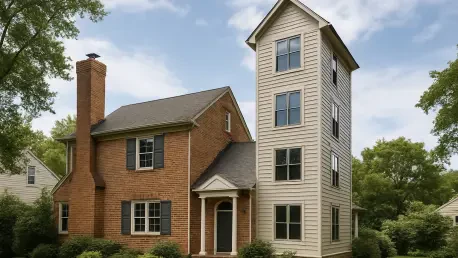In a quiet corner of Fairfax County, Virginia, a towering home addition in the Greenbriar neighborhood has sparked intense debate over local building regulations and community standards, raising critical questions about zoning laws and property rights. This three-story structure, attached to a home owned by Michael Nguyen, looms over neighboring properties, drawing sharp criticism for its imposing size and questionable aesthetics. Beyond mere appearance, the project has raised deeper concerns about the balance between individual needs and collective harmony. As frustration mounts among residents, county officials are now forced to confront gaps in current regulations, making this case a potential turning point for suburban planning. This situation not only highlights personal and cultural motivations behind such constructions but also underscores the urgent need for updated policies in densely populated areas.
Community Reactions and Challenges
Neighborly Discontent Over Visual Impact
The scale of the home addition in Greenbriar has left many neighbors reeling from its overwhelming presence in their once-uniform suburban landscape. Standing at 30 feet high and stretching 60 feet long, the structure casts a literal and figurative shadow over adjacent properties, particularly that of Courtney Leonard, whose single-story home sits just 8 feet from the massive wall. Residents have voiced dismay over the loss of sunlight and privacy, with some likening the addition to a commercial building rather than a residential extension. The visual dominance has fueled fears of declining property values, as the structure disrupts the neighborhood’s aesthetic cohesion. This discontent reflects a broader concern about how individual projects can alter the character of a community, leaving many to question whether current zoning rules are equipped to prevent such outcomes. The emotional toll on neighbors is palpable, as they grapple with a changed environment that feels imposed rather than negotiated.
Privacy and Property Value Concerns
Beyond the immediate visual impact, the towering addition has sparked significant worries about privacy and long-term financial repercussions for Greenbriar residents. Homeowners near the structure report feeling exposed, as the height allows for potential overlooking into private yards and windows, eroding a sense of personal space. Additionally, there’s a growing anxiety that the addition could deter future buyers, who might shy away from properties overshadowed by such an imposing neighbor. This fear is compounded by the perception that the structure deviates from the neighborhood’s established norms, potentially labeling the area as less desirable. For residents like Leonard, the issue transcends aesthetics, touching on fundamental aspects of homeownership and security. The clash between one homeowner’s expansion and the collective well-being of the community underscores a critical tension, highlighting the need for clearer boundaries in zoning enforcement to protect both individual and shared interests.
Regulatory Responses and Future Implications
Zoning Violations and County Intervention
In response to mounting complaints, Fairfax County officials have stepped in to address the controversial home addition, uncovering specific zoning violations that have temporarily halted construction. While the height of the structure complies with current regulations, the side yard setback falls short of the required 8 feet, prompting a stop-work order. County staff are now collaborating with the homeowner, Michael Nguyen, to resolve compliance issues, though a permanent solution remains uncertain. Supervisor Pat Herrity, alongside other local leaders, has championed a resolution to revisit building height restrictions, arguing that practical rules can prevent such disputes in the future. This intervention signals a recognition of the inadequacy of existing laws to handle modern housing demands, particularly in suburban areas experiencing rapid change. The county’s actions reflect a broader push to balance property rights with community standards, though the outcome of this specific case remains a point of contention.
Cultural Motivations and Policy Reform
Amid the regulatory scrutiny, the homeowner’s motivations add a layer of complexity to the debate, as the addition was designed to accommodate a multigenerational family. Nguyen’s intent to provide space for his elderly parents, wife, and young children aligns with cultural values prioritizing family care over institutional solutions like nursing homes. Plans for extra bedrooms, an office, and a playroom underscore a personal necessity that clashes with neighborhood expectations. This perspective has sparked discussions about how zoning laws can adapt to diverse family structures and cultural practices without compromising community harmony. The push for policy reform, driven by supervisors and supported by some residents, aims to address these evolving needs through updated height and setback ratios. As Fairfax County navigates this case, the broader implication is clear: urban planning must evolve to reconcile individual aspirations with collective well-being, ensuring that regulations reflect both practical and cultural realities.
Path Forward for Suburban Planning
Looking back, the controversy in Greenbriar served as a catalyst for Fairfax County to reassess how zoning laws could better address modern housing challenges. The stop-work order and subsequent collaboration with the homeowner marked a pivotal moment in recognizing the limitations of outdated regulations. The resolution to explore stricter height and setback rules demonstrated a commitment to preventing similar conflicts, while still considering the diverse needs of residents. This case highlighted the delicate balance between personal property rights and neighborhood integrity, urging officials to craft policies that anticipate future disputes. As a microcosm of larger urban planning issues, the situation prompted a deeper examination of how suburban areas could adapt to cultural shifts and population density. Moving forward, the emphasis was placed on creating flexible yet firm guidelines, ensuring that both individual homeowners and entire communities could thrive without friction.









